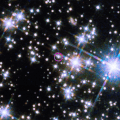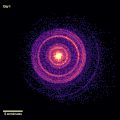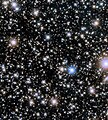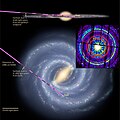File:NASA Missions Probe What May Be a 1-In-10,000-Year Gamma-ray Burst (SVS14317).webm
From Wikimedia Commons, the free media repository
Jump to navigation
Jump to search
Size of this JPG preview of this WEBM file: 800 × 450 pixels. Other resolutions: 320 × 180 pixels | 640 × 360 pixels | 1,024 × 576 pixels | 1,280 × 720 pixels | 1,920 × 1,080 pixels.
Original file (WebM audio/video file, VP8, length 51 s, 1,920 × 1,080 pixels, 986 kbps overall, file size: 5.95 MB)
File information
Structured data
Captions
Captions
Gamma-ray bursts are the most luminous explosions in the cosmos. Astronomers think most occur when the core of a massive star runs out of nuclear fuel, collapses under its own weight, and forms a black hole, as illustrated in this animation.
Summary[edit]
| DescriptionNASA Missions Probe What May Be a 1-In-10,000-Year Gamma-ray Burst (SVS14317).webm |
English: Gamma-ray bursts are the most luminous explosions in the cosmos. Astronomers think most occur when the core of a massive star runs out of nuclear fuel, collapses under its own weight, and forms a black hole, as illustrated in this animation. The black hole then drives jets of particles that drill all the way through the collapsing star at nearly the speed of light. These jets pierce through the star, emitting X-rays and gamma rays (magenta) as they stream into space. They then plow into material surrounding the doomed star and produce a multiwavelength afterglow that gradually fades away. The closer to head-on we view one of these jets, the brighter it appears. Credit: NASA's Goddard Space Flight CenterFind 4k master copies here. |
| Date | 28 March 2023, 17:50:00 (upload date) |
| Source | NASA Missions Probe What May Be a 1-In-10,000-Year Gamma-ray Burst |
| Author | NASA's Scientific Visualization Studio - Scott Wiessinger, Francis Reddy, Brad Cenko, Eric Burns |
| Other versions |
|
| Keywords InfoField | Swift; Galaxy; Supernova; Star; XMM-Newton observatory; Astrophysics; Gamma Ray; Space; Fermi; Black Hole; X-ray; Hubble Space Telescope; Gamma Ray Burst |
Licensing[edit]
| Public domainPublic domainfalsefalse |
| This file is in the public domain in the United States because it was solely created by NASA. NASA copyright policy states that "NASA material is not protected by copyright unless noted". (See Template:PD-USGov, NASA copyright policy page or JPL Image Use Policy.) |  | |
 |
Warnings:
|
File history
Click on a date/time to view the file as it appeared at that time.
| Date/Time | Thumbnail | Dimensions | User | Comment | |
|---|---|---|---|---|---|
| current | 03:46, 21 January 2024 | 51 s, 1,920 × 1,080 (5.95 MB) | OptimusPrimeBot (talk | contribs) | #Spacemedia - Upload of https://svs.gsfc.nasa.gov/vis/a010000/a014300/a014317/Gamma-ray_Burst_Animation_MkII_1080.webm via Commons:Spacemedia |
You cannot overwrite this file.
File usage on Commons
The following 16 pages use this file:
- File:NASA Missions Probe What May Be a 1-In-10,000-Year Gamma-ray Burst (SVS14317 - 221009A and friends v2).gif
- File:NASA Missions Probe What May Be a 1-In-10,000-Year Gamma-ray Burst (SVS14317 - ACE Wind).gif
- File:NASA Missions Probe What May Be a 1-In-10,000-Year Gamma-ray Burst (SVS14317 - Dust rings in Milky Way plan side 2160).jpg
- File:NASA Missions Probe What May Be a 1-In-10,000-Year Gamma-ray Burst (SVS14317 - Dust rings in Milky Way plan side 2160 no labels).jpg
- File:NASA Missions Probe What May Be a 1-In-10,000-Year Gamma-ray Burst (SVS14317 - Fermi Swift burst).gif
- File:NASA Missions Probe What May Be a 1-In-10,000-Year Gamma-ray Burst (SVS14317 - GRB WFC3IR1108+1204 circled).gif
- File:NASA Missions Probe What May Be a 1-In-10,000-Year Gamma-ray Burst (SVS14317 - GRB WFC3IR mstr crop FINAL no annotations 2160).jpg
- File:NASA Missions Probe What May Be a 1-In-10,000-Year Gamma-ray Burst (SVS14317 - GRB all rings XMM 2500).jpg
- File:NASA Missions Probe What May Be a 1-In-10,000-Year Gamma-ray Burst (SVS14317 - GRB location and sightline 2160).jpg
- File:NASA Missions Probe What May Be a 1-In-10,000-Year Gamma-ray Burst (SVS14317 - Gaia burst).gif
- File:NASA Missions Probe What May Be a 1-In-10,000-Year Gamma-ray Burst (SVS14317 - Mars burst).gif
- File:NASA Missions Probe What May Be a 1-In-10,000-Year Gamma-ray Burst (SVS14317 - Swift rings 221009A labels 1080).gif
- File:NASA Missions Probe What May Be a 1-In-10,000-Year Gamma-ray Burst (SVS14317 - Swift rings 221009A no labels 1080).gif
- File:NASA Missions Probe What May Be a 1-In-10,000-Year Gamma-ray Burst (SVS14317 - V1 burst).gif
- File:NASA Missions Probe What May Be a 1-In-10,000-Year Gamma-ray Burst (SVS14317 - grb position from Earth Sagitta outline 2160).jpg
- File:NASA Missions Probe What May Be a 1-In-10,000-Year Gamma-ray Burst (SVS14317 - grb position from Earth marker only 2160).jpg
Transcode status
Update transcode statusMetadata
This file contains additional information such as Exif metadata which may have been added by the digital camera, scanner, or software program used to create or digitize it. If the file has been modified from its original state, some details such as the timestamp may not fully reflect those of the original file. The timestamp is only as accurate as the clock in the camera, and it may be completely wrong.
| Software used |
|---|















